| |
|
|
| |
The St. Kitts train's unique profile by the tropical sea |
|
| |
|
|
| |
STEVE HITES, AMERICAN DREAMER
Steve Hites has built his various careers around his passion for railroading, proving the adage "Do what you love, the money will follow". He is a singer, songwriter, and an author. His entrepreneurial ventures have enhanced the economy of a small town – and even a small country. In the scenario that defines the American Dream, Hites started at the bottom, laying railroad ties. Soon he was wearing a conductor's hat in Alaska. By 1988, as Manager of Passenger Operations, he helped reopen the White Pass and Yukon Railway. It had ceased all operations after its main customer, a mining operation, shut down. These days, the born-again railroad, based in Skagway as a passenger-only excursion railroad, is popular with Alaska cruise passengers.
THE ST. KITTS SCENIC RAILWAY
In 2002, Hites’ investors group started the St. Kitts Scenic Railway on an island in the West Indies. Hites now enjoys cool summers in Alaska with his Skagway Street Car Company, which provides sightseeing and entertainment to tourists. In the winter, he moves south to the unspoiled Caribbean island of St. Kitts.
The volcanic Caribbean island of St. Kitts displays extravagantly green peaks, fields of pineapples, papaya, guava, banana and palm trees—and a tourist train. The St. Kitts Scenic Railway is powered by a tiny, odd-looking diesel with old-fashioned driver rods. Built in Romania, three such narrow-gauge engines hauled sugar beets in Poland until 2001. For their next assignment, they arrived here by ocean freighter. So, coincidentally, engines from a northern Polish sugar beet railway are now sunning themselves on the tracks of a Caribbean sugar cane railway. |
|
| |
|
|
| |
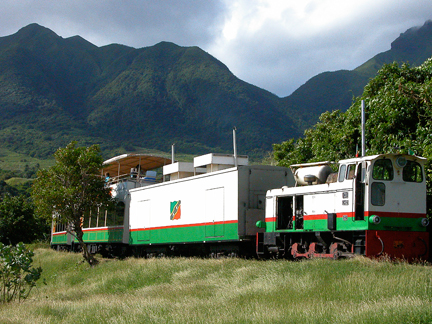 |
|
| |
Spotted backwards to give the engineer a clear forward view, the little Romanian diesel with driving rods powers the train |
|
| |
|
|
| |
The train's carriages wear festive red, white, and green livery—the colors of the national flag—and look like they're all dressed up for a party. Each passenger has two seats. One on the open top deck, protected by a sunshade and cooled by the tropical breezes. |
|
| |
|
|
| |
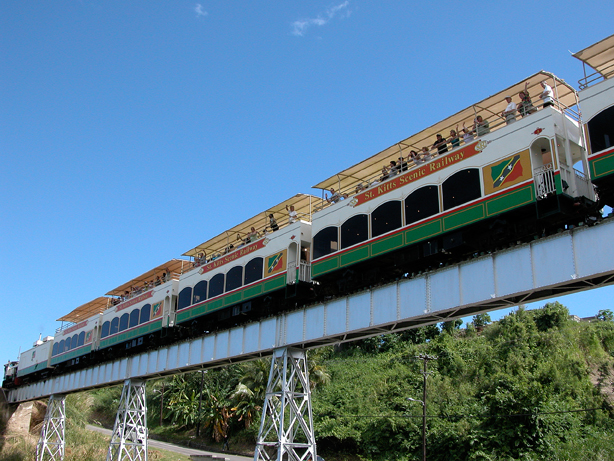 |
|
| |
Passengers view the island from the upper deck of the train |
|
| |
|
|
| |
The other is in the air conditioned lower level parlor featuring six-foot windows and cushioned rattan chairs. |
|
| |
|
|
|
|
| |
 |
|
 |
|
| |
The lower deck has big glass windows and rattan chairs |
|
Passengers view Nevis, St. Kitts' sister island |
|
| |
|
|
| |
As the quaint little string of railcars waddles along the tracks, it passes black sand beaches buffered with walls of huge volcanic rocks. Out to sea, other islands, resembling the mythical Bali Hai from the movie South Pacific, beckon. The closest, Nevis (St. Kitts’ sister island) completes an independent, two-island federation.
Tropical drinks are served; hauntingly harmonized voices of an onboard a cappella choir render songs such as "I've Been Working on the Railroad". |
|
| |
|
|
| |
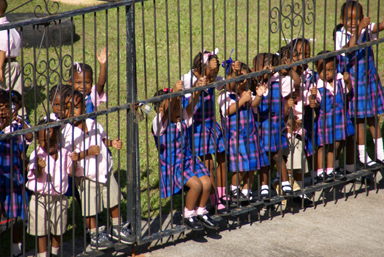 |
|
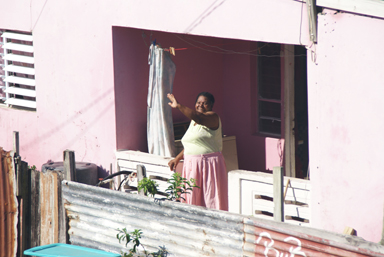 |
|
| |
School kids come out to wave |
|
Residents wave |
|
| |
|
|
|
|
| |
Children dash out of school buildings to wave as the train shuffles past; adults stop whatever they're doing, smiling and waving. The train is dear to the hearts of the islanders, and a source of pride, too. |
|
| |
|
|
| |
A narrator explains the lengthy history of St. Kitts and its fantastic "Sugar Wars": "Like many tourist trains, this one originally transported extracted products; in this case, sugar cane. Once a British possession, St. Kitts had 200 sugar-producing estates, worked by African slaves. The sweet stuff was popular with Europeans, and so valuable that naval forces and armies engaged in furious battles for sugar here. In 1690, the British put slaves to work building the gigantic Brimstone Hill Fortress, visible here from the train tracks, to house and protect their military forces. It took over 100 years to complete. |
|
 |
|
| |
|
|
The conductor smiles as the St. Kitts & Nevis flag waves in the background |
|
| |
|
|
|
|
| |
|
|
| |
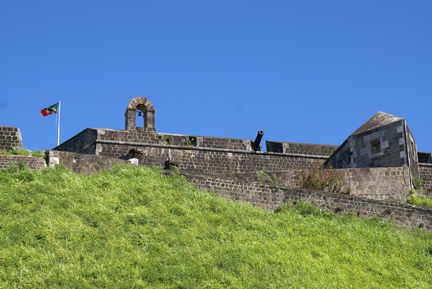 |
|
| |
The Brimstone Hill Fortress took 100 years to build |
|
| |
|
|
| |
Eight thousand French infantry once besieged Brimstone Hill, and St. Kitts changed hands eight times between the battling European powers. In 1912, a central sugar factory and narrow gauge railway were constructed. Near the end of the 20th century, competition, and sugar made from beets, dampened demand for St. Kitts sugar. The British departed, and St.Kitts and nearby Nevis became one independent federation. The St.Kitts Sugar Manufacturing Corporation hung on until 2005, when it closed. Three hundred and fifty years of sugar production had come to an end. |
|
| |
|
|
| |
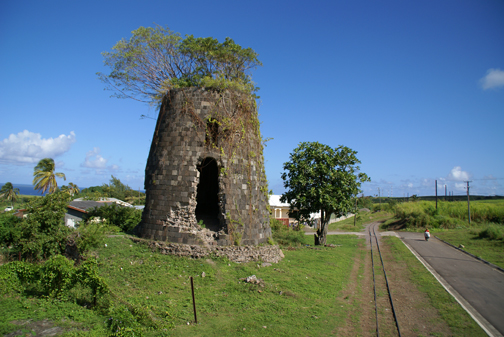 |
|
| |
The island's ruined structures attest to 350 years of sugar production |
|
| |
|
|
| |
As their main industry was declining, the islander's concerns about unemployment grew. But the government welcomed a new private corporation, the St. Kitts Scenic Railway Ltd., which began carrying passengers in 2003. Thus a new industry began, as employees of the downscaling Sugar Manufacturing Corporation began to work on the railway, making our little-known island of interest to tourists."
The Railway is owned by three American investors, including Steve Hites, who explains: "We signed our agreement opening the St. Kitts Scenic Railway, and then watched the sugar industry close. I had seen a similar thing happen in 1982 when I was with the White Pass and Yukon Route Railroad. The Yukon mines closed and we lost 85% of our business. Five-and-a-half years later we reopened the White Pass as a tourist-only railroad. In 2011 the WP&YR will carry about 356,000 passengers during the Alaska cruise season. It is one of the most successful tourist railways in the world. This transformation from freight to tourism saved the town of Skagway, Alaska, and breathed new life into the railroad.
"I miss the old days on the WP&YR, and I miss the days of the sugar industry in St. Kitts. I feel very fortunate to have seen them. But in both cases we found a way to keep a part of the old and find a way to transition into the new. The St. Kitts Scenic Railway is the ultimate poster child for the economic transition from an old mono-culture sugar economy to the new tourism and services economy. It is the connecting, surviving link between two eras, and thus has great value to the people of St. Kitts, and to the visitors who come to see this beautiful little island."
| |
 |
|
| |
Grade crossing with no gates is colorfully identified |
|
Most people arrive in St. Kitts by ship, booking the St. Kitt's Scenic Railway as a shore excursion. Several cruise lines stop here, including Princess, Carnival, Voyages of Discovery, Norwegian Cruise Lines, Cunard, and Star Clipper. "This railway plans to carry about 52,000 passengers in 2011," claims Hites. "The future for the little "Sugar Train" looks very bright."
Visit www.stkittsscenicrailway.com. The St. Kitts Scenic Railway Ltd. is located at Sands Unit A6, Bay Road, P.O. Box 191 Basseterre, St. Kitts, West Indies; phone 1 (869) 465-7263. Email indiesscenicreservations@sisterisles.kn |
|
| |
|
|
|
|
|


